
The House of Wittelsbach is a German dynasty, with branches that have ruled over territories including Bavaria, the Palatinate, Holland and Zeeland, Sweden, Hungary, Bohemia, the Electorate of Cologne and other prince-bishoprics, and Greece. Their ancestral lands of the Palatinate and Bavaria were Prince-electorates, as well as the Archbishopric-Electorate of Cologne, and the family had three of its members elected emperors and kings of the Holy Roman Empire. They ruled over the Kingdom of Bavaria which was created in 1805 and continued to exist until 1918.

Oppenheim is a town in the Mainz-Bingen district of Rhineland-Palatinate, Germany. The town is a well-known wine center, being the home of the German Winegrowing Museum, and is particularly known for the wines from the Oppenheimer Krötenbrunnen vineyards.

The Nahe is a river in Rhineland-Palatinate and Saarland, Germany, a left tributary to the Rhine. It has also given name to the wine region Nahe situated around it.

The Albertinum is a modern art museum. The sandstone-clad Renaissance Revival building is located on Brühl's Terrace in the historic center of Dresden, Germany. It is named after King Albert of Saxony.

The Palatinate Forest, sometimes also called the Palatine Forest, is a low-mountain region in southwestern Germany, located in the Palatinate in the state of Rhineland-Palatinate. The forest is a designated nature park covering 1,771 km2 and its highest elevation is the Kalmit.

Trifels Castle is a reconstructed medieval castle at an elevation of 500 m (1,600 ft) near the small town of Annweiler, in the Palatinate region of southwestern Germany. It is located high above the Queich valley within the Palatinate Forest on one peak of a red sandstone mountain split into three. Trifels Castle is on the peak of the Sonnenberg, and on both of the other two rock elevations there are castle ruins: Anebos Castle and Scharfenberg Castle.

Hambach Castle is a castle near the urban district Hambach of Neustadt an der Weinstraße in Rhineland-Palatinate, Germany. It is considered a symbol of the German democracy movement because of the Hambacher Fest which occurred here in 1832.

Ramberg is a municipality in Südliche Weinstraße district, in Rhineland-Palatinate, western Germany.
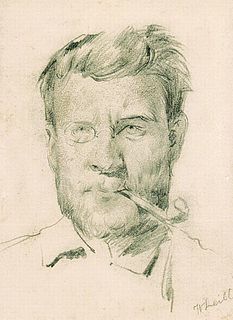
Johann Sperl was a German painter.

An imperial castle or Reichsburg was a castle built by order of the Holy Roman Emperor, whose management was entrusted to Reichsministeriales or Burgmannen. It is not possible to identify a clear distinction between imperial castles and the fortified imperial palaces or Pfalzen, because many imperial castles were used by German kings for temporary stays. Many imperial castles were built in regions such as Swabia, Franconia, the Palatinate and the Alsace, where there were a high density of imperial estates (Reichsgüter) during the Hohenstaufen era.
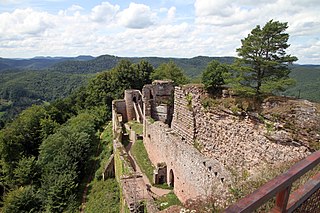
The castle of Neuscharfeneck is a ruin and a cultural monument above Ramberg and Dernbach on the territory of an exclave of Flemlingen in the district of Südliche Weinstraße in the west German state of Rhineland-Palatinate.

The Roßberg near Ramberg in the county of Südliche Weinstraße in the German state of Rhineland-Palatinate is, at 637 m above sea level (NHN), the third highest mountain in the Palatine Forest.
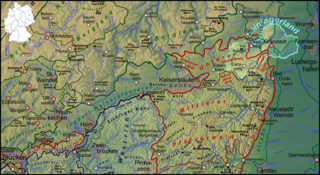
The Leiningerland is an historic landscape in the Palatinate region in the German federal state of Rhineland-Palatinate. It is named after an aristocratic family that used to be the most important in the region, the House of Leiningen.

The Modenbach is a stream, just under 30 kilometres (19 mi) long, and a right-hand tributary of the Speyerbach in the German state of Rhineland-Palatinate.
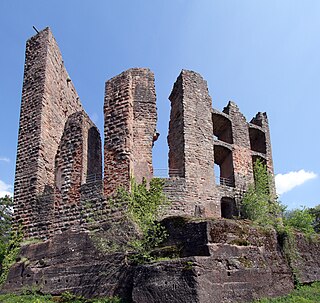
The Ramburg is a ruined hill castle in the county of Südliche Weinstraße, in the German state of Rhineland-Palatinate.

The Frankenburg is a natural monument with the ruins of a rock castle in the county of Südliche Weinstraße in the German state of Rhineland-Palatinate. It lies above the Modenbach valley on a rocky outcrop of the Frankenberg called the Frankenfelsen and was built to guard the road opposite Meistersel Castle.

Drei Buchen is a hill pass in the central Palatine Forest in the German state of Rhineland-Palatinate. It lies in the estate of the village of Ramberg at a height of 403 metres above sea level (NHN). The L 506 state road runs over the pass from Ramberg to Weyher. At the top of the pass is an inn, the Waldhaus Drei Buchen. The name Drei Buchen means "Three Beeches".

The Brushmakers' Museum in Ramberg is a local history museum in the village of Ramberg in the German state of Rhineland-Palatinate. The responsible body that set the museum up in 1997 and has run it since then is the Local History and Museum Society of the Brushmakers' Workshop, Ramber.
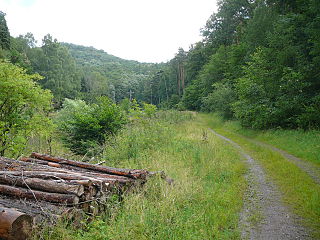
The Holpertal is a valley, just one and a half kilometres long, in the central Palatine Forest of Germany. It lies within the municipality of Ramberg in the county of Südliche Weinstraße in the state of Rhineland-Palatinate. Its V-shaped cross-section was cut by the waters of the Holperbach stream, which has incised deeply into the rock layers of the Lower Bunter. The valley floor climbs from an elevation of about 250 metres to well over 400 metres. Its slopes are covered with mixed forest and sweet chestnut. Whilst at one time, the valley produced raw materials for the traditional broom and brush-making industries, today forestry and tourism predominate.

Ingenheim is a village belonging to the municipality of Billigheim-Ingenheim in the district Südliche Weinstraße in the Rhineland-Palatinate, Germany. Up to 1969, Ingenheim had been an autonomous borough.






















